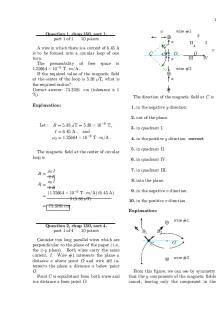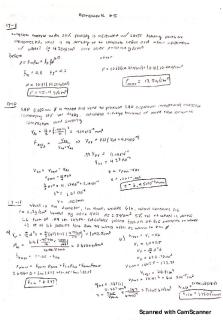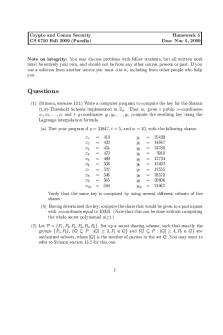Homework 5. Copula simulation Matlab python PDF

| Title | Homework 5. Copula simulation Matlab python |
|---|---|
| Author | Anonymous User |
| Course | Credit Risk Models |
| Institution | Baruch College CUNY |
| Pages | 2 |
| File Size | 61.2 KB |
| File Type | |
| Total Views | 141 |
Summary
quant risk management homework 5 detailed solution...
Description
Columbia University Quantitative Risk Management IEOR-4602
A. Capponi Fall 2021
Issued: November 18, 2021 Due: BEFORE CLASS November 30, 2021
Problem Set #5
Note: Please put the number of hours that you spent on this homework set on top of the first page of your homework. Ex. 1. This question is based on the methodology developed by CreditMetrics for evaluating the credit risk of corporate bond portfolios and other credit sensitive securities. The goal in this question is to estimate the 99% VaR of a portfolio of risky bonds. All of the data for this question may be downloaded from the Excel spreadsheet CorporateBondPortfolioData.xls that has been posted on CourseWorks. Moreover, a Matlab file, CorpBondPortfolio.m, has also been posted on CourseWorks. This file reads all of the relevant data in from the spreadsheet and contains some comments and commands that you can use to complete the task. The portfolio consists of 20 corporate bonds of varying maturities, face values, coupons, maturities, and credit ratings. In any given year, the rating of a corporate bond may change from one level to another. The dynamics of this process are given by the Ratings Transition Matrix in the spreadsheet. Note that we are implicitly assuming that ratings dynamics are governed by a Markov chain where the current rating is sufficient to determine the probability distribution of next year’s rating. The spreadsheet also contains the 1-year forward curves that should be used to value bonds of differing ratings one year from now. Finally the spreadsheet contains a 20 × 20 correlation matrix. This correlation matrix is the correlation matrix of the Gaussian copula that is used to determine the joint transition ratings of the 20 bonds. (The marginal ratings are given by the Ratings Transition Matrix. If a bond defaults over the next year you may assume that a recovery rate of R = 40% applies so that the investor will be left with a bond that is worth 40% of the bond’s face value. (We could easily allow for a random recovery value that varies with the bond’s seniority class but we will just take it to be constant here.) Do the following: (a) Simulate n = 10, 000 scenarios for the portfolio gain / loss one year from now. This gain / loss should be calculated relative to the value of the portfolio one year from now if none of the ratings changed. Estimate the mean, standard deviation, and 99% VaR and CVaR for this portfolio. Compute approximate 95% confidence intervals for the mean and standard deviation. (An approximate confidence interval for the 99% VaR and CVaR could also be calculated. It is more complicated, however, so you are not expected to do this.) (b) If you assumed that the portfolio gain / loss is a given by a normal distribution with the same mean and standard deviation as you estimated in part (a), what would your estimate be for the 99% VaR? Ex. 2. 1
For i = 1, . . . , N , we define Xi = ai M +
q
1 − a2i Zi ,
where M, Z1 , . . . , ZN are i.i.d. standard normal random variables. Each of the factor loadings, ai , is assumed to lie in the interval [0, 1]. It is also clear that Corr(Xi , Xj ) = ai aj and that the Xi ’s are multivariate normally distributed, with covariance matrix equal to the correlation matrix, P, where Pi,j = ai aj for i 6= j. Let F (t1 , . . . , tN ) be the joint distribution for the default times of the N credits in the portfolio. We then assume F (t1 , t2 , . . . , tN ) = ΦP (Φ−1 (F1 (t1 )), . . . , Φ−1 (Fn (tn ))), where ΦP denotes the multivariate normal CDF with mean vector 0 and correlation matrix, P. Also, Fi (t) is the risk-neutral probability that the i-th credit defaults before time t, i.e. Xi ≤ t. In order to price credit derivatives with the Gaussian copula model above, we need to compute the portfolio loss distribution for a common fixed time t = t1 = . . . tN . Towards this end we let qi := Fi (t) denote the marginal (risk-neutral) probability of the ith credit defaulting by this time. Do the following: (a) Show that, conditional on M , the default events of the N credits are independent and their distributions Fi (t|M ) are given by −1 (q ) − a M Φ i i q Fi (t|M ) = Φ 2 1 − ai (b) Define pN (l, t|M ) to be the (risk-neutral) probability of l defaults before time t in a portfolio of N names conditional on M . We also assumed that Fi (t|M ), the risk-neutral probability that the ith name defaults before time t conditional on M , is known for i = 1, . . . , N . Assuming pk (l, t|M ) is known for l = 0, . . . , k, describe how you would compute pk+1 (l, t|M ) for l = 0, . . . , k + 1. (c) Now write a program using your answer to part (b) to compute pN (l, t|M ) for l = 1, . . . , N . Your code should begin with k = 0 and iterate until k = N . (d) Write down an expression for pN (l, t), i.e., the risk-neutral unconditional probability that there are a total of l defaults before time t in the portfolio of N names. Ex. 3. Let (·) be a risk measure on some convex cone, M , that satisfies the subadditivity and positive homogeneity axioms. Show that the monotonicity axiom is then equivalent to the requirement that (L) ≤ 0 for all L ≤ 0. Ex. 4. Referring to Example 1 of the lecture notes on Risk Measures (first lecture), show that the 99% VaR for X + Y is indeed 9.8 as stated.
2...
Similar Free PDFs

Mc simulation in python
- 8 Pages

Matlab Homework#1
- 6 Pages

Homework 1 Matlab
- 72 Pages

Homework #1 Matlab Programming
- 9 Pages

Homework 5
- 2 Pages

Homework 5
- 9 Pages

Homework 5
- 4 Pages

Hoework 5 - homework 5
- 3 Pages

Homework 5
- 2 Pages

HW 5 - Week 5 homework
- 6 Pages

Python
- 9 Pages

Chapter 5 HW - Homework
- 2 Pages

5 - online homework solution
- 8 Pages

Seminar assignments - Homework 5
- 1 Pages
Popular Institutions
- Tinajero National High School - Annex
- Politeknik Caltex Riau
- Yokohama City University
- SGT University
- University of Al-Qadisiyah
- Divine Word College of Vigan
- Techniek College Rotterdam
- Universidade de Santiago
- Universiti Teknologi MARA Cawangan Johor Kampus Pasir Gudang
- Poltekkes Kemenkes Yogyakarta
- Baguio City National High School
- Colegio san marcos
- preparatoria uno
- Centro de Bachillerato Tecnológico Industrial y de Servicios No. 107
- Dalian Maritime University
- Quang Trung Secondary School
- Colegio Tecnológico en Informática
- Corporación Regional de Educación Superior
- Grupo CEDVA
- Dar Al Uloom University
- Centro de Estudios Preuniversitarios de la Universidad Nacional de Ingeniería
- 上智大学
- Aakash International School, Nuna Majara
- San Felipe Neri Catholic School
- Kang Chiao International School - New Taipei City
- Misamis Occidental National High School
- Institución Educativa Escuela Normal Juan Ladrilleros
- Kolehiyo ng Pantukan
- Batanes State College
- Instituto Continental
- Sekolah Menengah Kejuruan Kesehatan Kaltara (Tarakan)
- Colegio de La Inmaculada Concepcion - Cebu

